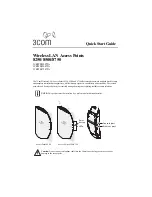
SHARC EZ-Extender Manual
2-3
EZ-Extender Hardware Reference
populating a socket with an oscillator. Only one of these sources can be
used at a time, the other sources must be disabled. For more information
on how to disable the
TX_CLK
sources, see
nect Jumper (P10)” on page 2-5
. The
RX_CLK
signal is generated by the
target board. Both the
TX_CLK
and
RX_CLK
can connect to the processor’s
clock-in signal (
DAI_P2_CLOCKIN
) as an input. See
Source Control Switch (SW1)” on page 2-3
for more information.
The ADC interface has two general-purpose signals,
DAI_P15_GP1
and
DAI_P16_GP2
. The evaluation board with which the extender interfaces
determines how these signals are set up. For information on how to set the
direction and the source of these signals, refer to
Control Switch (SW1)” on page 2-3
.
The ADC interface connects to the PDAP of the ADSP-21262 processor.
The PDAP is multiplexed with the address and data bus. To avoid bus
contention with the memory devices on the EZ-KIT Lite, the driver con-
nected to the data bus of the ADC must be enabled. For more information
about enabling the data bus, see
“ADC HSC Interface” on page 1-1
DIP Switches and Jumpers
The following section describes the function of all of the jumpers and
switches on the EZ-Extender. Before connecting the extender, familiarize
yourself with each possible setting’s effect on your application.
Direction/Clock Source Control Switch (SW1)
A designated DIP switch,
SW1
, provides an independent direction control
for the general-purpose signals (
DAI_P15_GP1
and
DAI_P16_GP2
), as illus-
trated in
. Each signal can be hardwired to be either transmit or
receive, or can be changed in real time using the
DAI_P18
processor pin. If
the
DAI_P18
processor pin is intended for the direction control, ensure the
pin is not used for other purposes on the EZ-KIT Lite. When the
SW1
Содержание SHARC EZ-Extender
Страница 4: ......
Страница 22: ...DIP Switches and Jumpers 2 6 SHARC EZ Extender Manual...















































